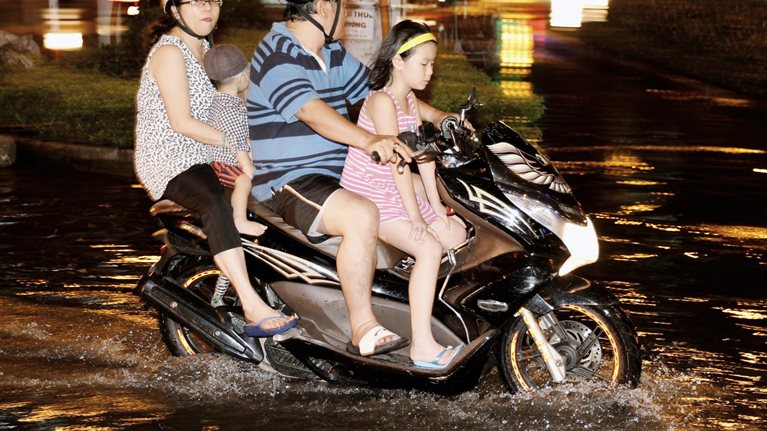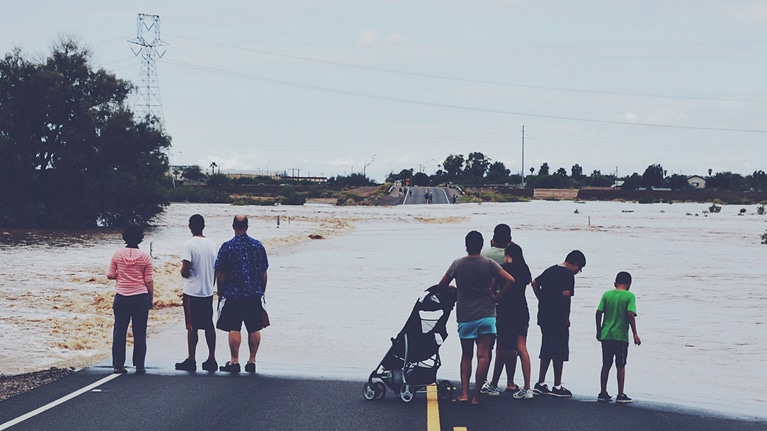Cities are on the front lines of the growing physical risks associated with climate change.1 They are home to more than half of the world’s people, and by 2050, that figure is projected to rise to 68 percent.2 Urban areas are often located in places of particular climate risk, such as on coastlines, floodplains, and islands. Moreover, modern urban infrastructure and its operating systems are closely connected. A failure in one part of a network can affect another, multiplying the damage. Flooded roads, for example, can damage links to public transport. Storm surges and extreme heat can lead to power outages that knock out the technology systems critical to homes, hospitals, and industries.
Given existing greenhouse-gas emissions, some climate change is already locked in, making such risks unavoidable. To protect the lives and livelihoods of urban residents, the imperative is to adapt—and to start now. Climate change could increase the severity and frequency of extreme heat, flooding, drought, and wildfires—the specific hazards addressed in this report.3 More than 90 percent of all urban areas are coastal; by 2050, more than 800 million urban residents could be affected by sea-level rise and coastal flooding.4 In addition, 1.6 billion people could be vulnerable to chronic extreme heat (up from 200 million today), and 650 million could face water scarcity.5
Because different cities face different climate risks and have varying levels of vulnerability, adaptation options that are effective in most may not be feasible in others. To manage that complexity, cities can concentrate on actions that play to their strengths (in resources, physical features and assets, and jurisdictional control) and offer a high return in risk reduction. Identifying such high-impact adaptations can be daunting, given the steadily developing nature of the climate threat and the dizzying array of adaptation options available.
This report, cowritten with C40 Cities Climate Leadership, a network of large cities that are committed to addressing climate change, seeks to help leaders set priorities and choose courses of action. It identifies a starting list of 15 high-potential actions that can work for many types of cities. The actions were chosen on the basis of three main sources: C40 Cities Climate Leadership and McKinsey analysis, consultation with adaptation experts and city leaders, and an extensive literature review.
There are two parts to the report. The first sets out the 15 actions. Four of them build systemic resilience, meaning they strengthen all kinds of cities. The other 11 are hazard specific, meaning they target particular physical climate risks. Some of the 15 actions, such as building barriers to protect coastal areas and retrofitting infrastructure, are complex and expensive. Others, such as planting trees next to streets and initiating behavioral-change programs to conserve water, aren’t. Examples from all over the world, in both advanced and developing economies, demonstrate what’s possible.
The second part of the report describes, in broad terms, how cities can implement the actions. We suggest that they begin by defining the most relevant hazards and by understanding the risks those hazards pose to their communities. On that basis, cities can then conduct detailed analyses of the risk-reduction impact, costs, and feasibility of different actions.
Several important themes emerge from the research. First, nature-based solutions—such as planting trees next to streets, river-catchment management, and sustainable urban-drainage solutions—are among the most attractive actions because of their impact on reducing risks and their feasibility. Nature-based solutions also often provide benefits beyond adaptation in areas such as decarbonization, economic growth, and health.6
Second, cities can invest in actions that increase resilience systemically, in addition to adapting to specific and immediate hazards. Systemic resilience includes increasing awareness of physical climate risks, incorporating risk awareness and preparedness into city processes, optimizing emergency responses, and enhancing financial and insurance programs.
Third, there’s an important equity element to climate-risk adaptation. Vulnerable populations, such as children, the elderly, low-income communities, some minority groups, people with disabilities, and women, may be at higher risk for climate-related damage. For example, continued rapid urbanization is leading to increased populations in informal settlements.7 They often lack the resources and adaptive capacity to withstand major events, such as floods and extreme heat.
Climate risk directly affects people (health, livability, and workability), assets (businesses, homes, and hospitals), and services (energy and food supply). This report can serve as a starting point to help cities develop their agendas for adaptation. Leaders will need to go deeper as they work out their strategies. Local knowledge is critical to success.
At the same time, climate adaptation is one of many competing priorities, and urban resources are limited. By identifying the most effective and feasible actions, cities can focus on executing them well and build momentum to do more. This report is a call to action—focused action. We hope that it will help cities play an important role in making swifter, surer progress toward a healthy and sustainable future.


